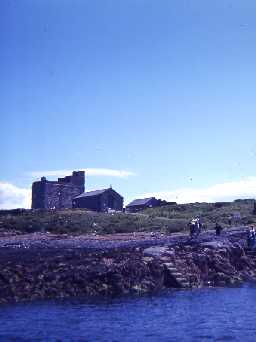Monastic settlement on Farne Island (Inner Farne) (North Sunderland and Seahouses)
(Centred NU 21803592) Farne Island. (1)
Farne Island or the Inner Farne as it is more usually called has had a special religious significance for over 1200 years, for it was here St Cuthbert died in AD687.
The island is first mentioned in AD651 when Bishop Aiden retired there. Cuthbert lived there from AD676-687 and after him a succession of hermits of whom only a few are known by name. By the 12th century the island seems to have lost much of its religious character. The last of the hermits was Thomas de Melsonby who died there in 1246.
All the Farne Islands belonged to the Prior and Convent of Durham, probably in the first place a gift of Bishop William de Carilef (1081-96). On the death of Thomas de Melsonby in 1246 the authorities at Durham determined that Farne Island should be inhabited by two monks of the Benedictine order. The first master was appointed in 1255. The House of Farne was dissolved in 1536.
After the dissolution of the monasteries the islands were granted to the Dean and Chapter of Durham. In 1673 Charles II authorised the establishment of a lighthouse on the island. Following this the Dean and Chapter granted a 21 year lease of 'Ferne Island' to Francis Liddle of Ogle and from then on the island had a succession of tenants until 1861 when it was sold to Archdeacon Thorp. In 1894 it was purchased by Lord Armstrong. (2)
(Description of Farne Island and its associations with St Cuthbert). (3)
Scheduled. (4)
Inner Farne. Reconstructions of what the site of Cuthbert's hermitage may have looked like (illus) in the 7th century show one or two cells with a church set within a circular enclosure with small garden plots
nearby. (5a)
NU 218 359. Monastic settlement on Farne Island. Scheduled No ND/104. (5b)
Additional reference (5c)
The monument is also visible as upstanding structures on air photographs part of the North East Coast Rapid Coastal Zone Assessment Survey. (5d)
Farne Island or the Inner Farne as it is more usually called has had a special religious significance for over 1200 years, for it was here St Cuthbert died in AD687.
The island is first mentioned in AD651 when Bishop Aiden retired there. Cuthbert lived there from AD676-687 and after him a succession of hermits of whom only a few are known by name. By the 12th century the island seems to have lost much of its religious character. The last of the hermits was Thomas de Melsonby who died there in 1246.
All the Farne Islands belonged to the Prior and Convent of Durham, probably in the first place a gift of Bishop William de Carilef (1081-96). On the death of Thomas de Melsonby in 1246 the authorities at Durham determined that Farne Island should be inhabited by two monks of the Benedictine order. The first master was appointed in 1255. The House of Farne was dissolved in 1536.
After the dissolution of the monasteries the islands were granted to the Dean and Chapter of Durham. In 1673 Charles II authorised the establishment of a lighthouse on the island. Following this the Dean and Chapter granted a 21 year lease of 'Ferne Island' to Francis Liddle of Ogle and from then on the island had a succession of tenants until 1861 when it was sold to Archdeacon Thorp. In 1894 it was purchased by Lord Armstrong. (2)
(Description of Farne Island and its associations with St Cuthbert). (3)
Scheduled. (4)
Inner Farne. Reconstructions of what the site of Cuthbert's hermitage may have looked like (illus) in the 7th century show one or two cells with a church set within a circular enclosure with small garden plots
nearby. (5a)
NU 218 359. Monastic settlement on Farne Island. Scheduled No ND/104. (5b)
Additional reference (5c)
The monument is also visible as upstanding structures on air photographs part of the North East Coast Rapid Coastal Zone Assessment Survey. (5d)
N5880
FIELD SURVEY, National Trust survey: the Farne Islands 2010; Archaeo-Environment Ltd
WATCHING BRIEF, Watching brief at the High Light, Inner farm
WATCHING BRIEF, Watching brief at the High Light, Inner farm
Disclaimer -
Please note that this information has been compiled from a number of different sources. Durham County Council and Northumberland County Council can accept no responsibility for any inaccuracy contained therein. If you wish to use/copy any of the images, please ensure that you read the Copyright information provided.
